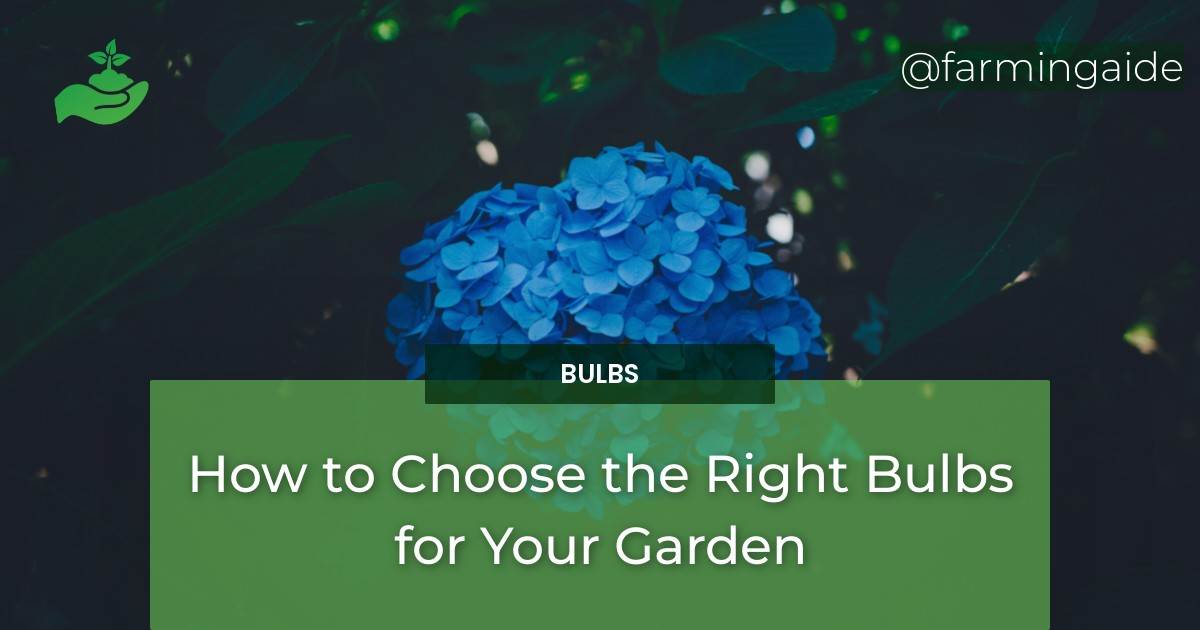If you are looking to add some color and texture to your garden, planting bulbs is a great way to do so. However, choosing the right bulbs for your garden can be a daunting task. With so many factors to consider, it’s important to know what to look for to ensure your bulbs will thrive. In this comprehensive guide, we will cover everything you need to know about how to choose the right bulbs for your garden, from factors to consider when selecting bulbs to types of bulbs and planting and maintenance tips.
Factors to Consider When Selecting Bulbs
Climate
Bulbs have different requirements when it comes to temperature and moisture. Some bulbs thrive in cold climates, while others prefer warmer temperatures. It’s important to choose bulbs that are suited for the climate in your area to ensure they will grow and bloom successfully.
Soil Type
Soil type is another important factor to consider when selecting bulbs. Bulbs prefer well-draining soil that is rich in organic matter. If your soil is heavy and clay-like, you can amend it with compost or other organic matter to improve drainage and fertility.
Sun Exposure
Most bulbs require full sun to bloom, but there are some exceptions. If your garden receives partial shade, you can choose bulbs that are suited for those conditions.
Bloom Time
Bulbs bloom at different times of the year, and it’s important to choose bulbs that will bloom when you want them to. Some bulbs bloom in spring, while others bloom in summer or fall.
Height and Spacing
It’s important to consider the height and spacing requirements of bulbs when selecting them for your garden. Some bulbs grow tall and need to be planted at the back of the border, while others are shorter and can be planted in the front.
Color and Texture
Bulbs come in a variety of colors and textures, and it’s important to choose bulbs that will complement the other plants in your garden. Consider the color scheme of your garden and choose bulbs that will add to it.
Types of Bulbs for Your Garden
Tulips
Tulips are one of the most popular bulbs for gardens. They come in a variety of colors and can be used to create stunning displays in the garden. Tulips prefer well-draining soil and full sun.
Daffodils
Daffodils are another popular bulb for gardens. They are easy to grow and come in a variety of sizes and colors. Daffodils prefer well-draining soil and full sun to partial shade.
Crocus
Crocus bulbs are small but mighty. They are one of the first bulbs to bloom in the spring and come in a variety of colors. Crocus bulbs prefer well-draining soil and full sun to partial shade.
Hyacinths
Hyacinths are known for their sweet fragrance and come in a variety of colors. They prefer well-draining soil and full sun to partial shade.
Alliums
Alliums are unique bulbs that add a whimsical touch to any garden. They come in a variety of sizes and colors and prefer well-draining soil and full sun.
Snowdrops
Snowdrops are small but mighty. They are one of the first bulbs to bloom in the spring and add a delicate touch to any garden. Snowdrops prefer well-draining soil and full sun to partial shade.
Iris
Iris bulbs come in a variety of colors and add a touch of elegance to any garden. They prefer well-draining soil and full sun.
ALSO READ
Planting and Maintenance Tips
Planting Depth
It’s important to plant bulbs at the correct depth to ensure they will grow and bloom successfully. As a general rule, bulbs should be planted at a depth that is three times their height.
Fertilization
Bulbs require nutrients to grow and bloom successfully. You can fertilize bulbs with a balanced fertilizer in the spring when they start to grow.
Watering
Bulbs require regular watering to grow and bloom successfully. Water bulbs deeply once a week, or more often if the weather is hot and dry.
Deadheading
Deadheading is the process of removing spent flowers from the plant. This promotes more blooms and keeps the plant looking tidy.
Dividing Bulbs
Over time, bulbs can become overcrowded and need to be divided. This is typically done in the fall when the foliage has died back.
What Are the Best Bulbs to Plant in My Garden?
When considering what to plant in your garden, don’t overlook the potential of different types of bulbs. Tulips, daffodils, and hyacinths are popular choices for spring blooms, while lilies and gladiolus can add color to your garden in the summer. Consider planting a variety for continuous blooms throughout the seasons.
Conclusion
Choosing the right bulbs for your garden can be a fun and rewarding experience. By considering factors such as climate, soil type, sun exposure, bloom time, height and spacing, and color and texture, you can create a beautiful and thriving garden. With the planting and maintenance tips outlined in this guide, you’ll be well on your way to a successful bulb garden.


